Xin Wu
DialogueReason: Rule-Based RL Sparks Dialogue Reasoning in LLMs
May 11, 2025Abstract:We propose DialogueReason, a reasoning paradigm that uncovers the lost roles in monologue-style reasoning models, aiming to boost diversity and coherency of the reasoning process. Recent advances in RL-based large reasoning models have led to impressive long CoT capabilities and high performance on math and science benchmarks. However, these reasoning models rely mainly on monologue-style reasoning, which often limits reasoning diversity and coherency, frequently recycling fixed strategies or exhibiting unnecessary shifts in attention. Our work consists of an analysis of monologue reasoning patterns and the development of a dialogue-based reasoning approach. We first introduce the Compound-QA task, which concatenates multiple problems into a single prompt to assess both diversity and coherency of reasoning. Our analysis shows that Compound-QA exposes weaknesses in monologue reasoning, evidenced by both quantitative metrics and qualitative reasoning traces. Building on the analysis, we propose a dialogue-based reasoning, named DialogueReason, structured around agents, environment, and interactions. Using PPO with rule-based rewards, we train open-source LLMs (Qwen-QWQ and Qwen-Base) to adopt dialogue reasoning. We evaluate trained models on MATH, AIME, and GPQA datasets, showing that the dialogue reasoning model outperforms monologue models under more complex compound questions. Additionally, we discuss how dialogue-based reasoning helps enhance interpretability, facilitate more intuitive human interaction, and inspire advances in multi-agent system design.
Out-of-Distribution Generalization in Time Series: A Survey
Mar 18, 2025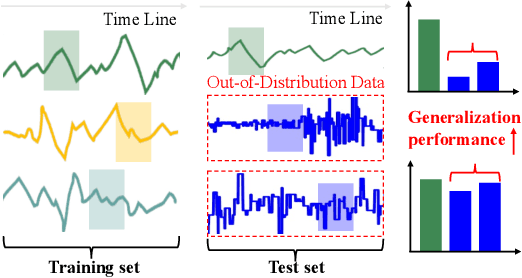
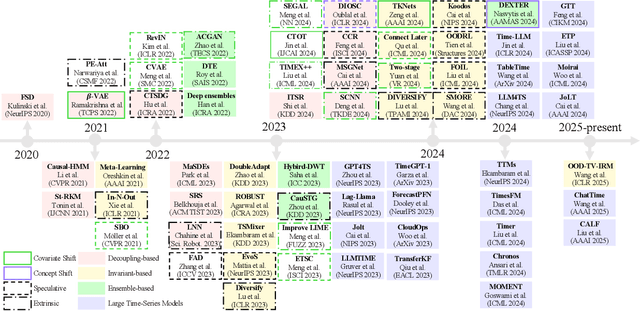
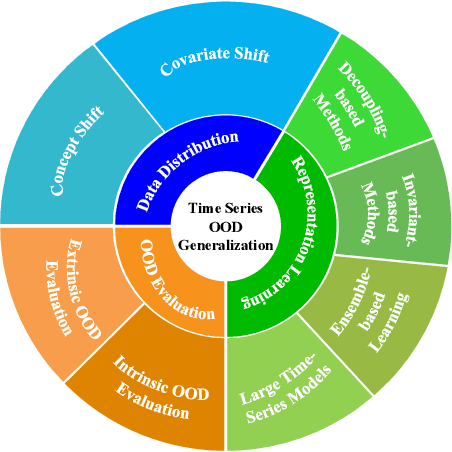
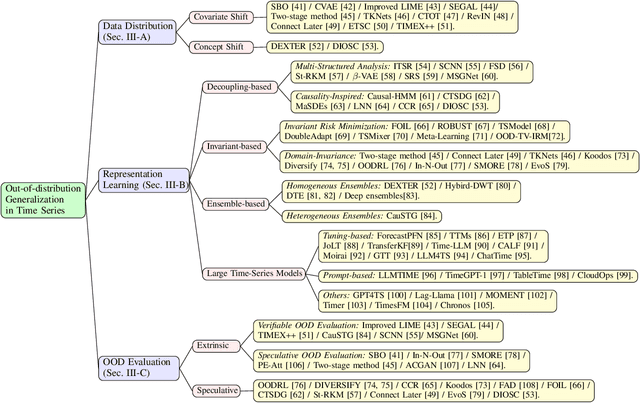
Abstract:Time series frequently manifest distribution shifts, diverse latent features, and non-stationary learning dynamics, particularly in open and evolving environments. These characteristics pose significant challenges for out-of-distribution (OOD) generalization. While substantial progress has been made, a systematic synthesis of advancements remains lacking. To address this gap, we present the first comprehensive review of OOD generalization methodologies for time series, organized to delineate the field's evolutionary trajectory and contemporary research landscape. We organize our analysis across three foundational dimensions: data distribution, representation learning, and OOD evaluation. For each dimension, we present several popular algorithms in detail. Furthermore, we highlight key application scenarios, emphasizing their real-world impact. Finally, we identify persistent challenges and propose future research directions. A detailed summary of the methods reviewed for the generalization of OOD in time series can be accessed at https://tsood-generalization.com.
Step-Audio: Unified Understanding and Generation in Intelligent Speech Interaction
Feb 18, 2025Abstract:Real-time speech interaction, serving as a fundamental interface for human-machine collaboration, holds immense potential. However, current open-source models face limitations such as high costs in voice data collection, weakness in dynamic control, and limited intelligence. To address these challenges, this paper introduces Step-Audio, the first production-ready open-source solution. Key contributions include: 1) a 130B-parameter unified speech-text multi-modal model that achieves unified understanding and generation, with the Step-Audio-Chat version open-sourced; 2) a generative speech data engine that establishes an affordable voice cloning framework and produces the open-sourced lightweight Step-Audio-TTS-3B model through distillation; 3) an instruction-driven fine control system enabling dynamic adjustments across dialects, emotions, singing, and RAP; 4) an enhanced cognitive architecture augmented with tool calling and role-playing abilities to manage complex tasks effectively. Based on our new StepEval-Audio-360 evaluation benchmark, Step-Audio achieves state-of-the-art performance in human evaluations, especially in terms of instruction following. On open-source benchmarks like LLaMA Question, shows 9.3% average performance improvement, demonstrating our commitment to advancing the development of open-source multi-modal language technologies. Our code and models are available at https://github.com/stepfun-ai/Step-Audio.
DULRTC-RME: A Deep Unrolled Low-rank Tensor Completion Network for Radio Map Estimation
Feb 07, 2025



Abstract:Radio maps enrich radio propagation and spectrum occupancy information, which provides fundamental support for the operation and optimization of wireless communication systems. Traditional radio maps are mainly achieved by extensive manual channel measurements, which is time-consuming and inefficient. To reduce the complexity of channel measurements, radio map estimation (RME) through novel artificial intelligence techniques has emerged to attain higher resolution radio maps from sparse measurements or few observations. However, black box problems and strong dependency on training data make learning-based methods less explainable, while model-based methods offer strong theoretical grounding but perform inferior to the learning-based methods. In this paper, we develop a deep unrolled low-rank tensor completion network (DULRTC-RME) for radio map estimation, which integrates theoretical interpretability and learning ability by unrolling the tedious low-rank tensor completion optimization into a deep network. It is the first time that algorithm unrolling technology has been used in the RME field. Experimental results demonstrate that DULRTC-RME outperforms existing RME methods.
Baichuan-Omni-1.5 Technical Report
Jan 26, 2025Abstract:We introduce Baichuan-Omni-1.5, an omni-modal model that not only has omni-modal understanding capabilities but also provides end-to-end audio generation capabilities. To achieve fluent and high-quality interaction across modalities without compromising the capabilities of any modality, we prioritized optimizing three key aspects. First, we establish a comprehensive data cleaning and synthesis pipeline for multimodal data, obtaining about 500B high-quality data (text, audio, and vision). Second, an audio-tokenizer (Baichuan-Audio-Tokenizer) has been designed to capture both semantic and acoustic information from audio, enabling seamless integration and enhanced compatibility with MLLM. Lastly, we designed a multi-stage training strategy that progressively integrates multimodal alignment and multitask fine-tuning, ensuring effective synergy across all modalities. Baichuan-Omni-1.5 leads contemporary models (including GPT4o-mini and MiniCPM-o 2.6) in terms of comprehensive omni-modal capabilities. Notably, it achieves results comparable to leading models such as Qwen2-VL-72B across various multimodal medical benchmarks.
Med-R$^2$: Crafting Trustworthy LLM Physicians through Retrieval and Reasoning of Evidence-Based Medicine
Jan 21, 2025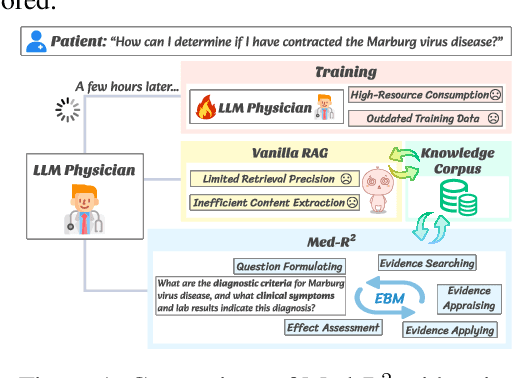
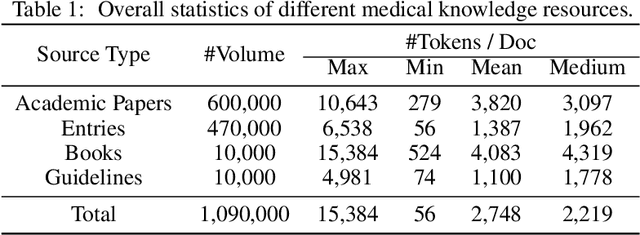
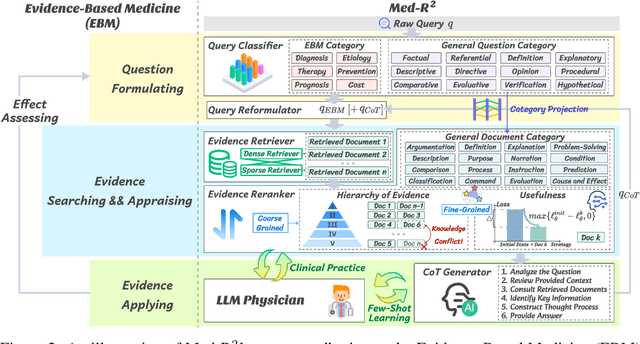
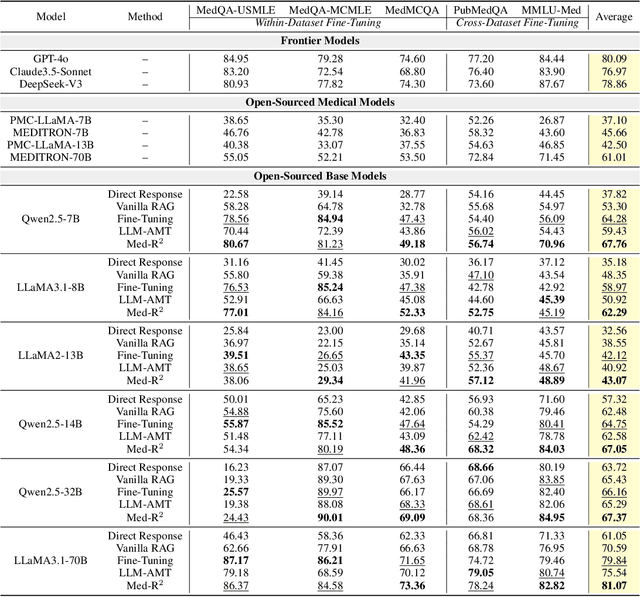
Abstract:In recent years, Large Language Models (LLMs) have exhibited remarkable capabilities in clinical scenarios. However, despite their potential, existing works face challenges when applying LLMs to medical settings. Strategies relying on training with medical datasets are highly cost-intensive and may suffer from outdated training data. Leveraging external knowledge bases is a suitable alternative, yet it faces obstacles such as limited retrieval precision and poor effectiveness in answer extraction. These issues collectively prevent LLMs from demonstrating the expected level of proficiency in mastering medical expertise. To address these challenges, we introduce Med-R^2, a novel LLM physician framework that adheres to the Evidence-Based Medicine (EBM) process, efficiently integrating retrieval mechanisms as well as the selection and reasoning processes of evidence, thereby enhancing the problem-solving capabilities of LLMs in healthcare scenarios and fostering a trustworthy LLM physician. Our comprehensive experiments indicate that Med-R^2 achieves a 14.87\% improvement over vanilla RAG methods and even a 3.59\% enhancement compared to fine-tuning strategies, without incurring additional training costs.
VersaTune: An Efficient Data Composition Framework for Training Multi-Capability LLMs
Dec 02, 2024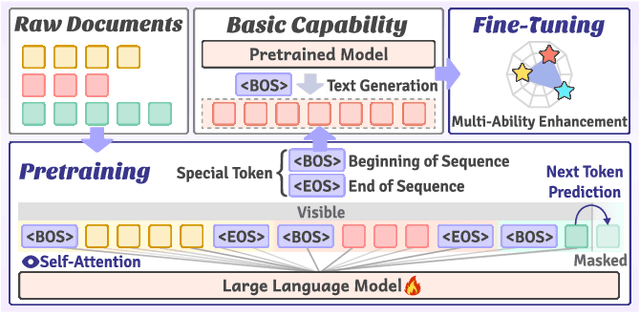



Abstract:Large-scale pretrained models, particularly Large Language Models (LLMs), have exhibited remarkable capabilities in handling multiple tasks across domains due to their emergent properties. These capabilities are further augmented during the Supervised Fine-Tuning (SFT) phase. Despite their potential, existing work mainly focuses on domain-specific enhancements during fine-tuning, the challenge of which lies in catastrophic forgetting of knowledge across other domains. In this study, we introduce VersaTune, a novel data composition framework designed for enhancing LLMs' overall multi-ability performances during training. We categorize knowledge into distinct domains including law, medicine, finance, science, code, etc. We begin with detecting the distribution of domain-specific knowledge within the base model, followed by the training data composition that aligns with the model's existing knowledge distribution. During the training process, domain weights are dynamically adjusted based on their learnable potential and forgetting degree. Experimental results demonstrate that VersaTune achieves significant improvements in multi-domain performance, with an 35.21% enhancement in comprehensive multi-domain tasks. Additionally, in scenarios where specific domain optimization is required, VersaTune reduces the degradation of performance in other domains by 38.77%, without compromising the target domain's training efficacy.
VersaTune: Harnessing Vertical Domain Insights for Multi-Ability LLM Supervised Fine-Tuning
Nov 24, 2024



Abstract:Large Language Models (LLMs) exhibit remarkable capabilities in handling multiple tasks across domains due to their emergent properties. These capabilities are further augmented during the Supervised Fine-Tuning (SFT) phase. Despite their potential, existing work mainly focuses on domain-specific enhancements during fine-tuning, the challenge of which lies in catastrophic forgetting of knowledge across other domains. In this study, we introduce VersaTune, a novel data composition framework designed for enhancing LLMs' overall multi-ability performances during fine-tuning. We categorize knowledge into distinct domains including law, medicine, finance, science, code. We begin with detecting the distribution of domain-specific knowledge within the base model, followed by the composition of training data that aligns with the model's existing knowledge distribution. During the fine-tuning process, weights of different domains are dynamically adjusted based on their learnable potential and forgetting degree. Experimental results demonstrate that VersaTune achieves significant improvements in multi-domain performance, with a 35.21% enhancement in comprehensive multi-domain tasks. Additionally, in scenarios where specific domain optimization is required, VersaTune reduces the degradation of performance in other domains by 38.77%, without compromising the target domain's training efficacy.
VersaTune: Fine-Tuning Multi-Ability LLMs Efficiently
Nov 18, 2024



Abstract:Large Language Models (LLMs) exhibit remarkable capabilities in handling multiple tasks across domains due to their emergent properties. These capabilities are further augmented during the Supervised Fine-Tuning (SFT) phase. Despite their potential, existing work mainly focuses on domain-specific enhancements during fine-tuning, the challenge of which lies in catastrophic forgetting of knowledge across other domains. In this study, we introduce VersaTune, a novel data composition framework designed for enhancing LLMs' overall multi-ability performances during fine-tuning. We categorize knowledge into distinct domains including law, medicine, finance, science, code. We begin with detecting the distribution of domain-specific knowledge within the base model, followed by the composition of training data that aligns with the model's existing knowledge distribution. During the fine-tuning process, weights of different domains are dynamically adjusted based on their learnable potential and forgetting degree. Experimental results demonstrate that VersaTune achieves significant improvements in multi-domain performance, with a 35.21% enhancement in comprehensive multi-domain tasks. Additionally, in scenarios where specific domain optimization is required, VersaTune reduces the degradation of performance in other domains by 38.77%, without compromising the target domain's training efficacy.
RemoteDet-Mamba: A Hybrid Mamba-CNN Network for Multi-modal Object Detection in Remote Sensing Images
Oct 17, 2024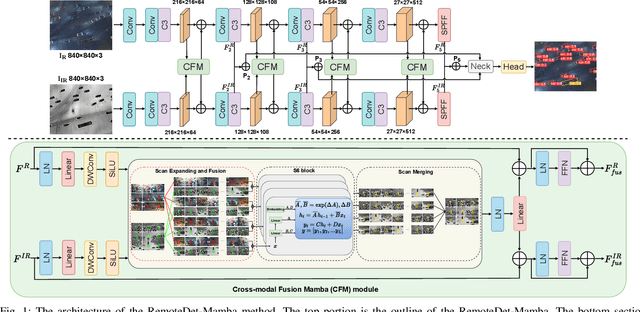
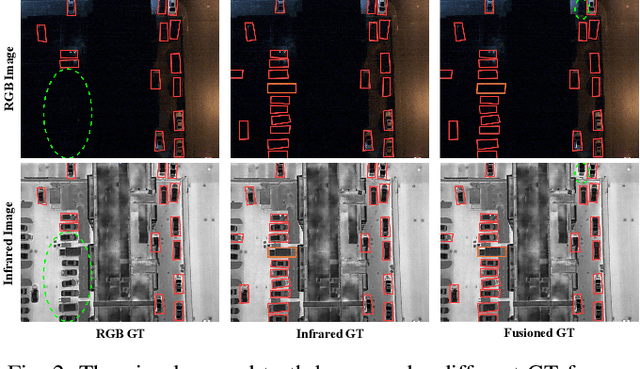
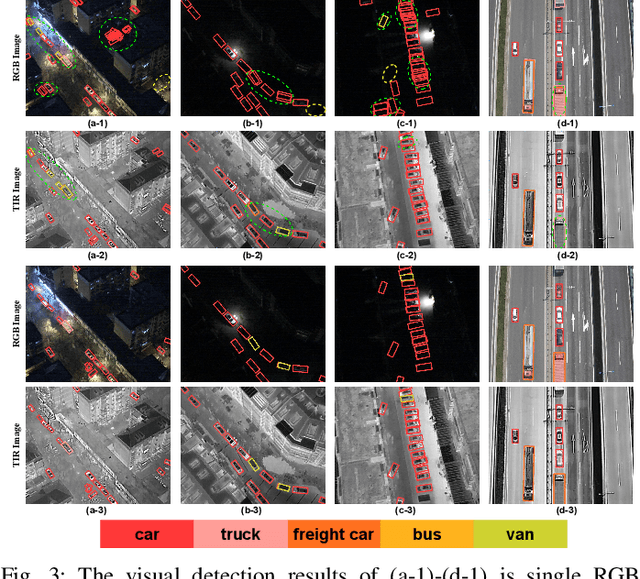
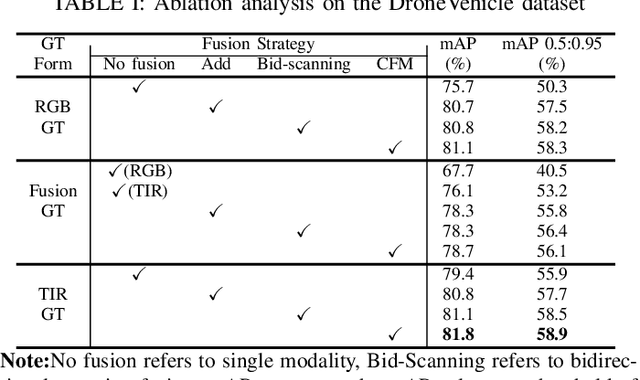
Abstract:Unmanned aerial vehicle (UAV) remote sensing is widely applied in fields such as emergency response, owing to its advantages of rapid information acquisition and low cost. However, due to the effects of shooting distance and imaging mechanisms, the objects in the images present challenges such as small size, dense distribution, and low inter-class differentiation. To this end, we propose a multimodal remote sensing detection network that employs a quad-directional selective scanning fusion strategy called RemoteDet-Mamba. RemoteDet-Mamba simultaneously facilitates the learning of single-modal local features and the integration of patch-level global features across modalities, enhancing the distinguishability for small objects and utilizing local information to improve discrimination between different classes. Additionally, the use of Mamba's serial processing significantly increases detection speed. Experimental results on the DroneVehicle dataset demonstrate the effectiveness of RemoteDet-Mamba, which achieves superior detection accuracy compared to state-of-the-art methods while maintaining computational efficiency and parameter count.
 Add to Chrome
Add to Chrome Add to Firefox
Add to Firefox Add to Edge
Add to Edge